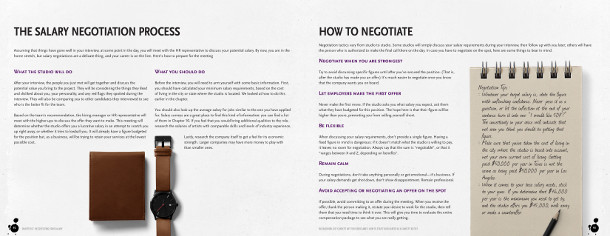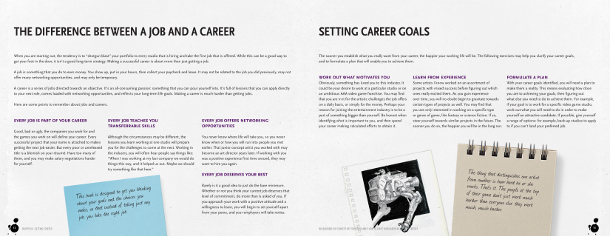10 tips for negotiating a better salary as a CG artist

One in four CG artists believes that they are being underpaid. Don’t let yourself become one of them. Instead, fight back with concept artist and author Eliott Lilly’s 10 career tips for negotiating a better salary.
According to a recent games industry survey, over one in four artists believe that they are not being paid fairly for the work they do. If you’re part of that group – or if you’re just starting out, and need some pointers on how to handle your first job – help is at hand.
Below, industry veteran Eliott Lilly, whose résumé includes AAA developers like id Software and Treyarch, reveals 10 practical tips for negotiating a better salary as a CG artist.
The article is based on Eliott’s latest book, The Big Bad World of Concept Art for Video Games: How to Start Your Career as a Concept Artist, but while the tips are written with concept work in mind, most of the advice applies equally to 3D art, and to other sectors of the industry, like VFX, feature animation and motion design.
1. Get your mind right
A games studio is a business like any other. To succeed, you need a business mindset. Try to see yourself as the studio does. What value does this candidate bring to our company? How will they make us more money? Can they help us work more efficiently? You need answers to these questions before you even start to negotiate, but they become really important when it’s time to make a counter-offer – more on that later.
During negotiations, don’t take anything personally or get emotional – it’s just business. Don’t make your personal circumstances part of the negotiation, either. Most companies aren’t swayed by emotional pleas like “I feel like I deserve more money” or “ I need more money so I can support my family”. These rarely yield the desired result. Instead, approach negotiations with a level head and solid facts.
2. Always negotiate!
The biggest mistake you can make is not negotiating at all. Studios will already have a salary range budgeted for the position you’re applying for, but will try to retain your services at the lowest possible price point (remember, it’s a business). Sometimes these salary ranges will be listed directly on the job posting, but in most cases, the figures will be kept confidential.
I suspect that studios rarely offer the higher end of that range first time round (unless they really want you). Therefore, don’t take the first offer: it may leave money on the table. At the very least, ask for 10% more.
This is especially true for women. A recent IGDA report, summarised in this article on Gamasutra, suggests that while entry-level salaries are similar for male and female employees, many fewer women reach the highest earnings brackets. Female freelancers also earn significantly less than their male counterparts.

For more salary negotiation advice, check out Eliott Lilly’s book, The Big Bad World of Concept Art for Video Games: How to Start Your Career as a Concept Artist. It includes an entire chapter devoted to the subject.
3. Establish a minimum salary floor
When deciding on your target salary, your first goal should be for the job to sustain your desired quality of life. Total up your current outgoings, and use this to calculate your base salary requirements for the state or country in which the studio is located. This will become your absolute cut-off.
If the initial offer is above this figure, you can negotiate more easily. If it is below, tell the studio so – but don’t say by how much. Let them re-pitch a new offer.
4. Do your research!
You should also look up the average salary for jobs similar to the one you have applied for. Industry surveys are a great place to find this kind of information. I personally used to use Game Developer magazine’s salary survey, and while the last one dates back to 2014 (you can read a summary here), you can find more recent examples on sites like GamesIndustry.biz and MCV.
If you feel that you bring additional qualities to the role, research the salaries of artists with comparable skills and levels of industry experience. I’ve checked sites like Glassdoor, Salary.com and PayScale in the past. They tend to report slightly different figures for the same job, so I visit them all to get a bracketed estimate.
Lastly, research the company itself to get a feel for its economic strength. Larger companies may have more money to play with than smaller ones.
5. Negotiate when you’re strongest
Try to avoid discussing specific figures until after you’ve secured the position. (That is, after the studio has made you an offer.) It’s much easier to negotiate once you know that the company wants you on board.
Whatever your target salary is, state the figure with unflinching confidence. Never pose it as a question, or let the inflection at the end of your sentence turn it into one: “I would like 60K?” The uncertainty in your voice will indicate that not even you think you should be getting that figure.
6. Always let company make first offer
Never make the first move. If the studio asks you what salary you expect, ask them: “What’s budgeted for this position?” The hope here is that their figure will be higher than yours, preventing you from selling yourself short. Leave your salary requirements blank on applications and politely skirt around the question when asked. You can say something like: “I will consider any fair or competitive offer”. Avoiding the question may not always work, so you may have to get creative with multiple responses here.

As well as tips on negotiating a better salary, Eliott’s book provides practical advice on building a portfolio, how to apply for jobs, what to do at job interviews, and how to avoid burnout over the course of your career.
7. Never accept on the spot
If possible, avoid committing to an offer during the meeting. When you receive the offer, thank the person making it, restate your desire to work for the studio, then tell them that you need time to think it over. This will give you time to evaluate the entire compensation package to see what you are really getting.
8. Always make a counter-offer
First, thank the employer for their job offer, and state that you are looking forward to working with the studio. Lead into the counter-offer with the assurance that the only thing stopping you from joining the team is a mutually agreeable salary. Expecting to be negotiated down, propose a salary that is a few thousand dollars higher than the figure you actually want.
9. Don’t be put off by the first ‘no’
In many cases, when you make a counter-offer, the company’s first reaction will usually be to reject it. (Of course it will – that’s business.) Don’t be put off or show disappointment. Remain professional.
Push back gently, justifying your proposed counter-offer and explain how the company will benefit from your services. If you’ve made it this far into the negotiation process, the chances are they really want to hire you.
10. Play up your strengths
Remember those business questions I mentioned in the first tip? Here’s where having the answers to them will help. When making a counter-offer, focus on the value you bring to the company.
For example, you might say: “I’d like to remind you that one of my strengths is that I am proficient in both 2D and 3D software, so I can take a task from concept all the way through to in-game asset creation. This will speed up your turnaround times and streamline your pipeline immensely.”
If you’re a senior artist, mention how your individual efforts helped bring your previous game to completion. Also remind your potential employers of any awards you’ve won, or any notable projects you worked on.
If you’re just starting out, play up your enthusiasm and work ethic. You can say something like: “I am young, energetic, and passionate about this game. While I don’t look forward to it, I have no problem working long hours during crunch periods. I have few distractions in my life and can commit fully to this project.” (You’ll be crunching anyway, but by mentioning it in your negotiations, at least you may get paid a bit more!)
Find more tips in How To Start Your Career as a Concept Artist
These tips are just one small part of my newest book, The Big Bad World of Concept Art for Video Games: How to Start Your Career as a Concept Artist. In it, I discuss everything you need to know about building and sustaining a career in the entertainment industry. Written for aspiring artists, it covers everything from how to structure your portfolio to attract the right studios to spotting the signs that it’s time to quit a failing project.
If you’ve enjoyed these salary negotiation tips, head on over to The Big Bad World of Concept Art website. You can even buy your own copy of the book there.
 About the author: Eliott Lilly is a freelance concept artist, adjunct professor, and published author. He has worked in the videogame industry for over a decade, working with Treyarch on Call of Duty: Black Ops 3 as lead multiplayer weapons concept artist. He regularly publishes careers advice on his blog, while you can see his own art at eliottlillyart.com
About the author: Eliott Lilly is a freelance concept artist, adjunct professor, and published author. He has worked in the videogame industry for over a decade, working with Treyarch on Call of Duty: Black Ops 3 as lead multiplayer weapons concept artist. He regularly publishes careers advice on his blog, while you can see his own art at eliottlillyart.com
Full disclosure: in my other life as a freelance technical writer, I helped to edit Eliott’s book. Neither I nor CG Channel have received any payment for this article or fees from sales of the book – Jim Thacker, Editor.
